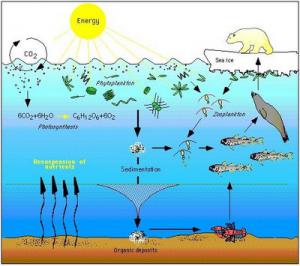Emerging threats: Plankton perilGlobal warming may affect oxygen-producing ocean phytoplankton
Past and current climate change has affected the food sources in the surface waters in the North Pacific Ocean. Climate change is predicted to alter marine phytoplankton (algae and diatoms) communities and affect productivity, biogeochemistry, and the efficacy of the biological pump. The slow global warming over the most recent approximate 150 years – roughly corresponding to the industrial revolution — has been beneficial, seeing an increase in nitrogen fixing cyanobacteria resulting in food production. “It’s sort of a carbon credit because the phytoplankton are making their own nitrogen-based fertilizer out of dissolved nitrogen,” says one researcher. But if global warming continues, the consequences may be dire. “This picoplankton community shift may have provided a negative feedback to rising atmospheric carbon dioxide, during the last 100 years. However, we cannot expect this to be the case in the future,” the researcher said.

Changes in one population ripples through entire food chain // Source: epa.gov
Past and current climate change has affected the food sources in the surface waters in the North Pacific Ocean.
New research by Lawrence Livermore National Laboratory and colleagues at the University of California, Santa Cruz, University of Colorado, and Universität zu Kiel in Germany, has found that there are distinct differences in how plankton respond to climate over the last 1,000 years.
The North Pacific Subtropical Gyre, the largest continuous ecosystem on Earth, has undergone major shifts in phytoplankton community composition associated with large-scale regional climate change. These findings have major implications for understanding past and future changes in open ocean productivity and food web dynamics, the efficacy of the biological pump and ocean biogeochemical cycling. A major finding is that the current North Pacific Subtropical Gyre plankton regime, characterized by enhanced nitrogen-fixing cyanobacterial production (a process in which algae and diatoms turn gaseous nitrogen into a food source), appears to have started around the end of the Little Ice Age and the beginning of the Industrial Era, and is likely unprecedented in the past 1,000 years.
LLNL reports that by using samples of Hawaiian gold corals (Kulamanamana haumeaae), which are extraordinarily long-lived, and useful paleo-environmental archives, the team used a new technique to analyze compound-specific individual amino acids found in the coral’s organic skeleton. “To reconstruct past plankton community composition dynamics, we applied a cutting-edge compound-specific stable isotope fingerprinting approach to deep-sea corals,” said lead author Kelton McMahon.
Deep-sea corals act as living sediment traps, filtering out sinking organic matter from the ocean surface. The stable carbon isotopes of the essential amino acids (those amino acids that only plants make) in the sinking organic matter (the debris of phytoplankton) are recorded, virtually unmodified, in the proteinaceous growth bands of the deep-sea coral skeleton. These isotopic fingerprints provide a diagnostic tracer of the phylogenetic identity of the plankton groups that made that sinking organic matter. Essentially, the coral’s skeleton acts like a strip-chart recorder for what the coral has fed upon. In this way one is able to reconstruct the relative contribution of different phytoplankton groups to the export production back through time.
The research appears in the 26 November edition of the Science Express.
Climate change is predicted to alter marine phytoplankton (algae and diatoms) communities and affect productivity, biogeochemistry, and the efficacy of the biological pump.
“We reconstructed high-resolution records of changing plankton community composition in the North Pacific Ocean over the past millennium,” said LLNL geochemist Tom Guilderson, one of the authors.
A key observation from this study is that the most recent approximate 150 years has seen an increase in nitrogen fixing cyanobacteria resulting in food production.
“It’s sort of a carbon credit because the phytoplankton are making their own nitrogen-based fertilizer out of dissolved nitrogen,” Guilderson said. “This is a big deal because as the oceans have warmed over the last 150 years, the surface water of the subtropical gyre has become more stable, allowing less nutrients (like nitrogen and phosphorous) from below to be entrained into the surface layer where the phytoplankton need this ‘fertilizer’ to grow and take up carbon from the atmosphere.
“This picoplankton community shift may have provided a negative feedback to rising atmospheric carbon dioxide, during the last 100 years. However, we cannot expect this to be the case in the future,” Guilderson said.
— Read more in Kelton W. McMahon et al., “Millennial-scale plankton regime shifts in the subtropical North Pacific Ocean,” Science (26 November 2015) (DOI: 10.1126/science.aaa9942)
